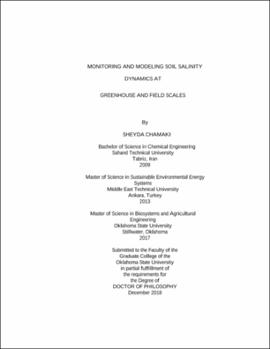| dc.contributor.advisor | Taghvaeian, Saleh | |
| dc.contributor.author | Chamaki, Sheyda | |
| dc.date.accessioned | 2023-04-26T16:20:28Z | |
| dc.date.available | 2023-04-26T16:20:28Z | |
| dc.date.issued | 2018-12 | |
| dc.identifier.uri | https://hdl.handle.net/11244/337478 | |
| dc.description.abstract | An integrated monitoring and modeling approach was undertaken in greenhouse and field scale in terms of three main studies. In the first study, the changes in soil salinity and several other chemical properties were investigated in an irrigation district during a period that experienced severe drought followed by above-normal precipitation. Soil salinity, represented by the electrical conductivity (EC) of the saturated paste, decreased for the top layers and increased for the bottom layers during the study period, suggesting that some level of leaching occurred. However, the change in EC was not statistically significant when averaged over the top 1.5 m of the soil profile | |
| dc.description.abstract | In the second study, a greenhouse experiment was conducted followed by numerical simulation to study performance of HYDRUS model in simulating the measured data. Six scenarios were defined based on irrigation water salinities and leaching application in soil columns under Bemudagrass. Soil profile salinity increased by increase in irrigation water salinity. Fresh water leaching was able to reduce soil salinities, which is a valid technique to offset the hazardous effects of saline irrigation and enable utilization of more saline irrigation water that are generally considered unsuitable for irrigation. HYDRUS simulation model performance was acceptable in predicting observed data.In the third study, the potential land application of saline water was studied using the validated model from the second study. Using HYDRUS model, a combination of 36 scenarios were simulated using various irrigation water quality and quantity in three different locations of Panhandle, Central, and Southwest Oklahoma. Based on the results of this experiment, similar to the second study, soil solution salinity increased by increase in irrigation water salinity. Hydrologic characteristics of the land applied location had a significant effect on the amount of salts accumulated in the root zone. Elevated precipitation in Central Oklahoma made it more suitable location for discharge of saline water. However, hyper-saline water added extended amounts of salts to the soil and downstream water resources. Further studies are required to investigate the environmental sustainability of the saline irrigation considering the impacts of salts released to the environment which can contaminate soil and downstream water resources. | |
| dc.format | application/pdf | |
| dc.language | en_US | |
| dc.rights | Copyright is held by the author who has granted the Oklahoma State University Library the non-exclusive right to share this material in its institutional repository. Contact Digital Library Services at lib-dls@okstate.edu or 405-744-9161 for the permission policy on the use, reproduction or distribution of this material. | |
| dc.title | Monitoring and modeling soil salinity dynamics at greenhouse and field scales | |
| dc.contributor.committeeMember | Zhang, Hailin | |
| dc.contributor.committeeMember | Stoodley, Scott | |
| dc.contributor.committeeMember | Wagner, Kevin | |
| osu.filename | Chamaki_okstate_0664D_16022.pdf | |
| osu.accesstype | Open Access | |
| dc.type.genre | Dissertation | |
| dc.type.material | Text | |
| dc.subject.keywords | drought | |
| dc.subject.keywords | irrigation | |
| dc.subject.keywords | Oklahoma | |
| dc.subject.keywords | saline irrigation | |
| dc.subject.keywords | soil salinity | |
| dc.subject.keywords | water quality | |
| thesis.degree.discipline | Environmental Science | |
| thesis.degree.grantor | Oklahoma State University | |
